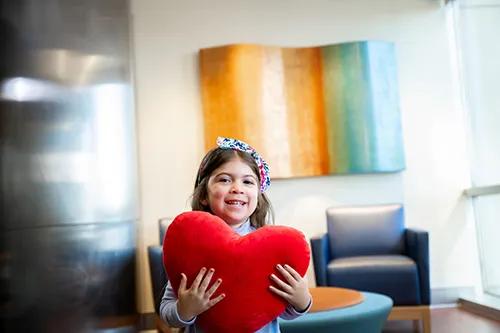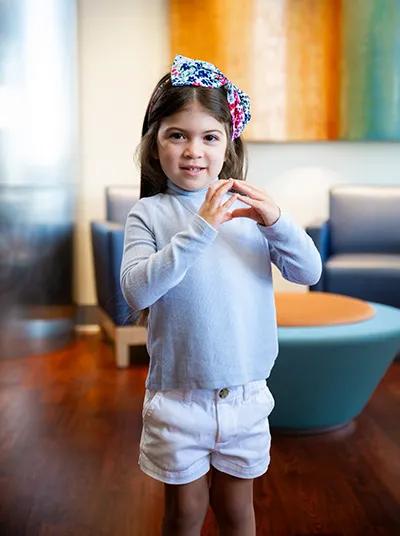
Meet Kennedy: who got her groove back
When Kennedy’s strength and coordination rapidly declined as a toddler, her parents turned to Children’s Health for answers and a new treatment
Kennedy is a vibrant 5-year-old who loves ballet, tap dancing and Taylor Swift. Sometimes she moves so quickly her parents can barely keep up.
Seeing her now, you wouldn’t guess that when she first came to Children’s HealthSM she couldn’t walk more than a few steps.
“She’s a fighter,” her mom, Chelsea, said. “I hope this experience teaches her just how strong she is. If she can overcome this, there’s nothing she can’t do.”
It all started when Kennedy was 3 years old, and her strength and coordination rapidly declined.
A rare autoimmune disease

At first, Kennedy’s parents thought she wanted to be picked up all the time because her baby brother was getting all the attention. She said her legs were tired, but that didn’t seem too unusual. Then, she started limping and had trouble climbing onto the couch.
“In a matter of weeks, she went from a typical toddler to not being able to sit, stand or hold her head up,” her dad, Fred, said.
They awaited a diagnosis with a neuromuscular specialist at a different hospital. Kennedy’s rapid loss of muscle control and coordination pointed to Duchenne Muscular dystrophy — a life-limiting condition where the average lifespan is about 20 years.
Her parents breathed a sigh of relief when testing revealed a different diagnosis: juvenile dermatomyositis -- a rare autoimmune disease that occurs when the immune system, which is supposed to fight off germs, gets confused and starts attacking the skin and muscles.
“We felt like we could deal with whatever was going to happen from there because we knew she was going to live,” Chelsea said.
A team of experts working together
Juvenile dermatomyositis is a lifelong disease with no cure. But with the right treatment, it can go into remission, which means long periods of time with no symptoms.
The frontline steroid treatment worked well for Kennedy at first. But about a year later, her blood pressure spiked and wouldn’t come down. That’s when they checked into the Children’s HealthSM Emergency Department — and learned that the steroid treatment was causing dangerously high blood pressure.
“That was the scariest part,” Chelsea said. “She was getting worse; it felt like time was against us. And she could no longer have the main treatment for this disease.”
Kennedy was admitted to the hospital. Soon, she had a team of Children’s Health experts from cardiology, nephrology and rheumatology working to find a new treatment and get her blood pressure under control.
The way to a 4-year-old’s heart: cats and pink bandages
The care team determined that a therapy called IVIG would be a good option to treat her juvenile dermatomyositis. The only downside was that it is an IV-based treatment – and Kennedy, like many kids, did not like being poked with a needle.
The nurses and Child Life team at Children’s Health knew exactly what to do.
They were great at helping her feel comfortable. Kennedy loves cats so several of them would talk to her about cats or show her videos of their cats. They always made sure she got a pink wrap after an IV because they knew it was Kennedy’s favorite color. Those small things really made a difference.
— Chelsea, Kennedy's Mom
What began as a trip to the ED turned into a nearly month-long stay in the hospital. Fred appreciated everything that made Children's Health feel like a place where his 4-year-old – who was now living with a complex disease – could still feel like a kid through the playroom and art therapy – services provided to patient families thanks to generous philanthropic support.

“We’ve been to other hospitals that feel scary and sterile,” Fred said. “But as soon as you walk in, Children’s Health is very kid-focused. There was a playroom where she could play with her brother. She loved the art supplies and painting these little figurines that she still has in her room.”
The family was bummed about spending Easter at the hospital, but they were grateful when the Easter Bunny came by with a basket for Kennedy. They were even more grateful when her doctors confirmed the IVIG therapy was working – her blood pressure was in a healthy range, and they could finally go home.
A bright and resilient future
These days, Kennedy is a kind, caring and smart 5-year-old with a big vocabulary and a great sense of humor. She likes putting pretend bandages on her teddy bears — and her little brother, when he cooperates.
“The first time we came to Children’s Health she was basically wheelchair-bound. We took her everywhere in a stroller,” Fred said. “So, to see how she’s doing now is pretty incredible.”
The family is deeply grateful for the expert care they’ve received and to all of the donors who believe in the organization.
“When you have a child with a chronic illness there are so many medical expenses," Chelsea said. “Donations that help families like ours cover the cost of care make all the difference.”
Meet more Children's Health patients
Read more patient stories like Kennedy's and meet our Patient Ambassadors to learn how Children's Health makes life better for children.
How you can help
Help kids like Kennedy by exploring our ways to give or by giving today!
Kids count on us. We count on you.
Give to support innovative research, lifesaving treatments and compassionate care.
Did you enjoy this story?
If you would like to receive an email when new stories like this one are posted to our website, please complete the form below. We won't share your information, and you can unsubscribe any time.

